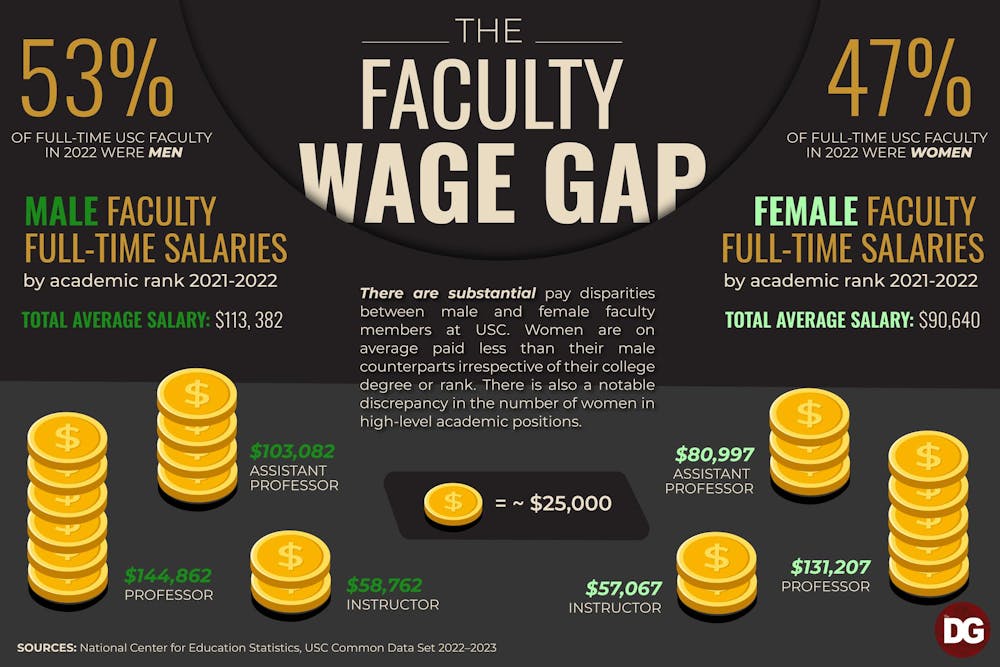Women working full-time as members of USC's faculty were paid on average 79.9% of the salary of their male counterparts at the university for the 2021-2022 academic year.
Women made up 47.2% of full-time faculty at USC in 2021, according to data from the Integrated Postsecondary Education Data System.
USC's faculty gender employment breakdown is on pace with national trends. Women made up 48% of full-time faculty at degree-granting postsecondary institutions nationwide in fall 2021.
But USC is behind the national standard for female faculty's salary. Women in faculty are paid on average 81.9% of the amount male faculty make in the United States.
That means for every dollar a male faculty member earns in the U.S., female faculty members will earn on average about 82 cents.
At USC, female faculty members will only earn on average around 80 cents for every dollar their male counterparts make.
Public data on professor salaries at USC, and at the national level, does not include gender identities other than male and female. USC's data also does not provide other demographic information such as race or sexual orientation.
Overall employment between male and female faculty is almost equal at USC, but women were less represented at higher academic ranks, such as professor.In 2021, 55.2% of instructors at USC were women, but only 35.7% of professors were women.
Though men made more money than women at every academic rank, discrepancies in pay varied at each rank.
The most equal academic rank was instructor, where women made 97.1% of their male counterparts' salaries. The assistant professor rank had the greatest discrepancy, with women making 78.6% of their male counterparts' salaries.
An instructor's primary responsibility is teaching courses, whereas faculty at higher professor ranks may be responsible for teaching, research and other requirements.
Carol Harrison, professor in the Department of History, said that gender pay differences at the university are not necessarily the result of intentional discrimination.
"I don't think we're ever looking at a case where, someone laughs evilly and says, 'Let's pay the women less,'" Harrison said. “What we’re thinking about is much more the cumulative effects of tiny bits of bias.”

One source of the salary differences between men and women may be that there are more men in higher-paying fields such as computer science and more women in lower-paying fields such as music, Harrison said.
"It might suggest that computer science should hire more women, and that's almost certainly true," Harrison said. "But again, it would not necessarily suggest discrimination."
But Harrison said salary may not be the only factor in how gender shapes employment at the university.
She said women and minority faculty often end up doing extra service in their department, such as serving on committees or mentoring students. These services are difficult to quantify and may not factor into salary considerations.
The Arnold School of Public Health is proactive in issues of inequality, according to Carrie Hendrix, business manager for USC's Montgomery Speech Language and Hearing Clinic.
"Our department is really intentional about equality and fairness and appreciation for everybody," Hendrix said.
William Matchin, an assistant professor in the Arnold School of Public Health, said that although the university has attempted to address inequalities in the institution, some issues persist.
“I feel like the university in general does a lot of work — I mean, it’s different across different departments — that tries to be inclusive and respectful,” Matchin said. "But for me, I include salary in 'inclusive and respectful'... Once you start to look at the salary issue, the wages, the benefits, then you see the dramatic disparity that pops up, and I think that has to be included as part of the equation.”
The university is committed to addressing disparities within the institution, Collyn Taylor, USC internal relations manager said.
"The University of South Carolina understands the need for equal pay in higher academic ranks and takes that very seriously," Taylor said in an email. "Historical pay disparities have been identified across all higher education, and USC is committed to addressing the issue."
Taylor said that the Office of Institutional Research, Assessment and Analytics regularly conducts campus-wide salary studies that examine how faculty salaries within each department on campus compare to salaries for faculty at comparable institutions.
Taylor also identified specific ways that USC is working to promote gender equality within the institution.
The Provost Advisory Committee on Women's Issues advocates for women faculty, staff and students at USC by assessing current policies and recommending new policies and procedures, Taylor said.
Taylor also said the university's Executive Leadership Academy provides nine-month professional development courses to diverse faculty and staff members with great potential to prepare them for executive-level leadership positions.

